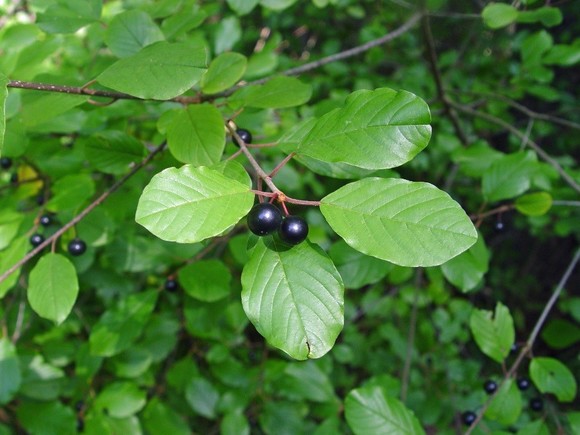|
It’s National Invasive Species
Awareness Week, so here is a profile of one of the top invasive plants in
Maine. Do you recognize glossy
buckthorn?
Glossy buckthorn (Frangula alnus)
is a tall, understory shrub from Europe that was brought to North America
in the early 1800s as an ornamental shrub, primarily to serve as hedges.
But this woody plant escaped from yards and landscaped areas long ago, invading
forests, fields, wetlands and lake shores.
Glossy buckthorn is extremely hardy
and able to thrive in a variety of soil and light conditions. It also
out-competes native plant species with its fast growth rate and extended
growing season — glossy buckthorn leafs out earlier in the spring and
holds its leaves later into fall, allowing it to continue to grow when most
native species are dormant.
The leaves and bark of glossy
buckthorn are not a gourmet treat for local wildlife. Look closely at a glossy
buckthorn leaf and you'll rarely see any spots or small holes. It has
no specific insect predators in North America. Deer also avoid it, instead
munching on native species and furthering glossy buckthorn’s competitive edge.
Combine these characteristics with
this shrub's plentiful seed production and it's not hard to see how it can
very quickly dominate a forest or streamside area, pushing out beneficial
plants.
Why glossy buckthorn matters
Impact on wildlife and forests
To us humans, a lakeshore dominated
by glossy buckthorn just looks like a lush sea of bright green leaves. But
invasions of glossy buckthorn reduce the abundance and diversity of butterflies
and bees, which are valuable pollinators. In addition, glossy buckthorn
out-competes native plants, resulting in fewer potential host plants for
leaf-eating insects like caterpillars, which are the main food source for many
nesting songbirds. Forest trees are also at risk from glossy buckthorn
competition. Because it is somewhat
shade-tolerant and can grow densely in the forest understory, glossy buckthorn
can dominate and crowd out the seedlings and saplings of desirable forest trees
like white pine. Foresters around New
England are finding that they need to take action in order to ensure that
desirable trees are able to come in after planned harvests, rather than
thickets of glossy buckthorn.
Bad for our lakes and streams
Because glossy buckthorn shades
out and out-competes native groundcover plants, it's bad for water quality.
Native groundcovers help stabilize soil and retain and absorb rainwater.
Without these native groundcover plants, rain water can move faster and pick up
more pollutants including soil particles that empty into nearby bodies of
water. The soil is rich in phosphorus which can feed nasty algae blooms.
What you can do
First, learn to recognize this
invasive species! Plants can grow in a
shrub form with many stems coming from the base, or as a small tree up to 25’
tall. It can look like a young birch or
cherry, with white lenticels on the bark, but the leaves have smooth edges (no
teeth). Glossy buckthorn’s branching
pattern is alternate along the twig – one leaf per node. Flowers are small, 5-parted, white-yellow,
and and appear where the leaf meets the stem in early summer. Glossy buckthorn can have unripe green fruit,
somewhat ripe red fruit, and ripe black fruit all on the same plant at
once. Roots are a deep red color.
Second, look for this plant on your
property, and take action to remove it. Do you have glossy buckthorn lurking at the edge of the stream, in your
woodlot, or even planted as a hedge? Consider
what you might do to get rid of it, or replace plantings over time. For more information on control methods,
visit the Maine Natural Areas Program's invasive plant photo gallery. You’ll find many more photos to help you
identify glossy buckthorn and links to videos demonstrating control techniques.
 
|